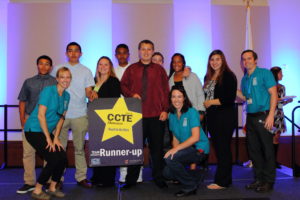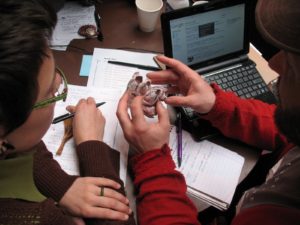Mention frog mucus to a group of tenth-graders and you might expect to hear a collective “yuck.” To a class of sophomores from Kearny High’s School of Engineering, Innovation and Design in San Diego, the slimy substance on frogs’ skin could be the clue to solving a big agricultural dilemma, using an emerging design practice called biomimicry.
Biomimicry is innovation inspired by nature—emulating nature’s strategies and patterns to create more sustainable technologies for people. At Kearny High last year, a group of teachers developed an entire semester-long, project-based learning exercise centered on the Biomimicry Global Design Challenge, a competition hosted by the Biomimicry Institute and sponsored by the Ray C. Anderson Foundation.

Caption: Kearny High School sophomores won an award in a San Diego, CA district science competition for their Biomimicry Global Design Challenge project.
In 2015 and 2016, the Challenge focused on designing a better food system using nature as a guide. The Kearny High students researched how strategies found in nature could inform better ways of preventing food waste, making food packaging more sustainable, and, in the case of the team inspired by frog mucus, keeping moisture in the soil. Not only did the students love the project, the school won second place in a district-wide science competition.
“When you bring nature into a project, the kids get really excited. It makes it more engaging,” said Kearny High English teacher and project lead Emily Liebenberg. “[Biomimicry is] such a growing thing that’s gaining popularity, and they felt like they were on the brink of something exciting.”
All over the world, people from all professional backgrounds are discovering that the clues to creating more sustainable products, materials, and even cities can be found in nature. At the Biomimicry Institute, we strongly believe that real change will come about by equipping the next generation to confront our toughest sustainability challenges head-on with this new way of thinking and problem solving. Biomimicry-based education is not only a way to engage K–12 students with real-world lessons in physics, chemistry, and biology content; but perhaps most importantly, biomimicry offers kids tangible solutions and a hopeful vision for the future of our planet.
Contemporary science education is changing rapidly and biomimicry can help prepare students for both the careers of the future as well as the real-world challenges that their generation will be facing. Biomimicry supports the development of the design, engineering and problem-solving skills so important to education today. And at a time when the movement around STEM/STEAM has placed engineering concepts and practices prominently within youth education—even in the youngest grades—biomimicry offers teachers an accessible and compelling platform for sharing ideas that doesn’t require fancy equipment or STEM labs to do so, because nature is outside all the time!
For example, you can ask your students, “What does the curve of an eagle’s wing have to do with the upturned wingtips on commercial jets?” The answer is a lesson in aerodynamics and the physics of drag and lift. You might ask, “What do wetlands have to do with clean water?” This can begin a dialogue about ecology, biodiversity, and nutrient cycles that can then be connected to water treatment issues.
At the Smithsonian Environmental Research Center, outreach coordinator Karen McDonald used this approach to blend biology and technology in a lesson exploring hydraulics with 8 to 12 year old students. SERC has a research program studying blue crabs in the Chesapeake Bay, and McDonald developed an education program in which students learn about an interesting phenomenon that occurs when blue crabs molt (shed their shells in order to grow).

When a crab sheds its old shell, its new shell is still soft and needs up to 48 hours to harden. During this time it must rely on water pressure inside its skeleton to help it move around. This is called a hydrostatic skeleton. After teaching students about the biology, Karen introduced the concepts of hydraulics and pneumatics in mechanical systems and provided a demonstration using syringes and aquarium tubing. The students were then given an engineering challenge to take what they just learned and design a mechanical arm that could go up and down using syringes, water, and a variety of simple building materials. The students grasped the idea quickly and, modeling the concept in physical form, reinforced their understanding of the mechanics and how human designs and natural strategies can have similar functions.
Beyond offering hands-on lessons and experiential applications of STEM concepts, biomimicry provides a positive, action-oriented framework to explore solutions to some of our biggest sustainability problems. Many educational efforts around environmental problems like climate change focus on dire predictions like severe weather, extinctions of iconic species, and ecosystem collapse. While it’s important to understand the full weight of the problem, leaving the lesson there can be deeply depressing, for both students and teachers. Biomimicry offers a sense of possibility and a way to teach about environmental challenges that remains hopeful. It gives a message that a sustainable world exists all around us and empowers students to think “I can make things better.”
Kids need a hopeful vision for the future and meaningful calls to action that excite them with a sense of possibility and agency in their future. Incorporating biomimicry into the classroom not only offers students a way to learn by going outside, getting dirty, and observing natural wonders, but it also provides them with a new, deeply hopeful lens on the world. With this lens, we can give our future scientists, architects, designers, and world-changers the tools to create the radically sustainable solutions we so desperately need today.


